check engine PONTIAC GRAND AM 2003 Owner's Manual
[x] Cancel search | Manufacturer: PONTIAC, Model Year: 2003, Model line: GRAND AM, Model: PONTIAC GRAND AM 2003Pages: 354, PDF Size: 16.3 MB
Page 244 of 354

Engine Air Cleanedfilter
2.2L L4 ECOTEC Engine shown, 3400 V6 Engine
similar
The engine air cleanedfilter is located in the engine
compartment on the driver’s side of the vehicle.
more information on location.
v’lru ~tayt~~u VVII~~U~L~~~C/II~ VYUL Y,UYY VI, yuyu u IL IVI Cnn f‘nmnovtmnrrt fbtnnt;-tA, nn -T)NP, E iq Car
To check or replace the engine air cleanedfilter, do the
following:
1. Remove the screws that hold the cover on.
3. Check or replace the engine air cleanedfilter.
4. Put the cover back on tightly.
Refer to the Maintenance Schedule
to determine when
to replace the air filter.
See
Part A: Scheduled Maintenance Services on
page 6-4.
Operating the engine with the air cleanerifilter
off can cause you or others to be burned. The
air cleaner not only cleans the air,
it stops
flame if the engine backfires. If
it isn’t there
and the engine backfires, you could be burned. Don’t drive with
it off, and be careful working
on the engine with the air cleanedfilter
off.
ivsrrce: ~i the air cieaneritiiter is oii, a backiire can
cause a damaging engine fire. And, dirt can
easily get into your engine, which will damage
it.
Always have the air cleanerifilter in place when
you’re driving.
2. Lift off the cover.
5-2 1
Page 246 of 354
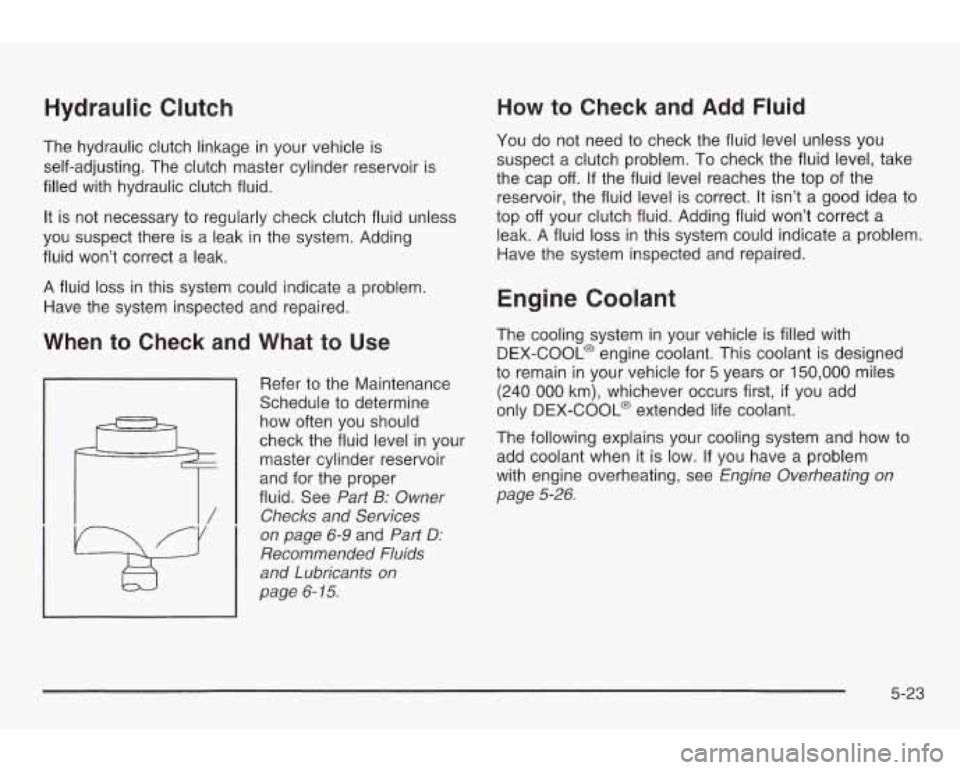
Hydraulic Clutch
The hydraulic clutch linkage in your vehicle is
self-adjusting. The clutch master cylinder reservoir is
filled with hydraulic clutch fluid.
It is not necessary
to regularly check clutch fluid unless
you suspect there is a leak in the system. Adding
fluid won’t correct a leak.
A fluid
loss in this system could indicate a problem.
Have the system inspected and repaired.
When to Check and What to Use
Refer to the Maintenance
Schedule
to determine
how often you should
check the fluid level in your
master cylinder reservoir
and for the proper
fluid. See
Part B: Owner
Checks and Services
on page
6-9 and Part 19:
Recommended Fluids
and Lubricants on
page
6- 15.
How to Check and Add Fluid
You do not need to check the fluid level unless you
suspect a clutch problem. To check the fluid level, take
the cap
off. If the fluid level reaches the top of the
reservoir, the fluid level is correct. It isn’t a good idea to
top
off your clutch fluid. Adding fluid won’t correct a
leak. A fluid loss in this system could indicate a problem
Have the system inspected and repaired.
Engine Coolant
The cooling system in your vehicle is filled with
QEX-COOL@ engine coolant. This coolant is designed
to remain in your vehicle for
5 years or 150,000 miles
(240 000 km), whichever occurs first, if you add
only QEX-COOL@ extended life coolant.
The following explains your cooling system and how to
add coolant when it is low. If you have a problem
with engine overheating, see
Engine Overheating on
page
5-26.
5-23
Page 248 of 354
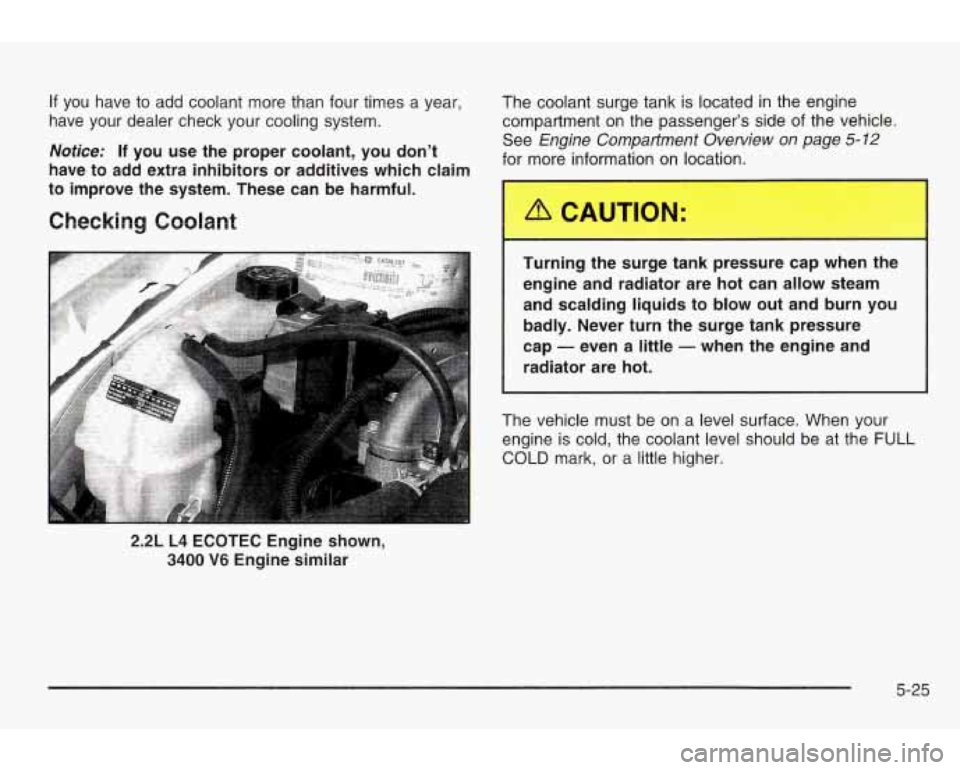
If you have to add coolant more than four times a year, The coolant surge tank is located in the engine
have your dealer check your cooling system. compartment
on the passenger’s side of the vehicle.
Notice: If you use the proper coolant, you don’t
have to add extra inhibitors or additives which claim
to improve the system. These can be harmful. See
Engine Compartment
Overview on page 5-12
for more information on location.
Checking Coolant
1
Turning the surge tank pressure cap when the
engine and radiator are hot can allow steam
and scalding liquids to blow out and burn you
badly. Never turn
the surge tank pressure
cap
- even a little - when the engine and
radiator are hot.
The vehicle must be on a level surface. When your
engine is cold, the coolant level should be at the
FULL
COLD mark, or a little higher.
2.2L L4 ECOTEC Engine shown,
3400 V6 Engine similar
5-25
Page 253 of 354
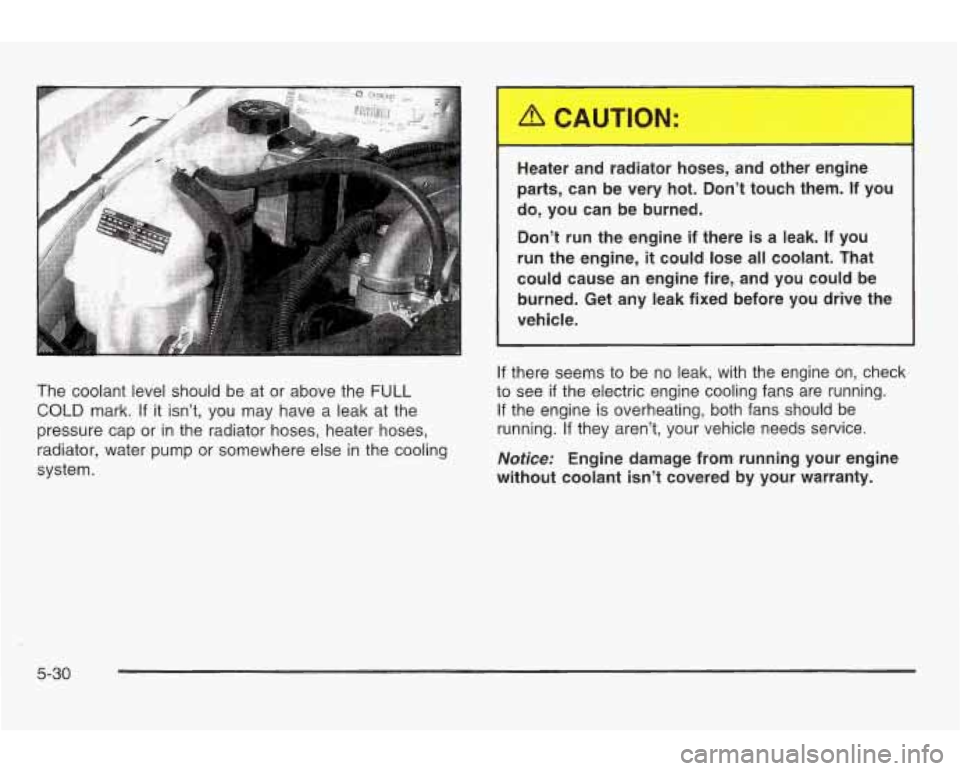
Heater and radiator hoses, and other engine
parts, can be very hot. Don't touch them. If you
do, you can be burned.
Don't run the engine
if there is a leak. If you
run
the engine, it could lose all coolant. That
could cause an engine fire, and you could be
burned. Get any leak fixed before you drive
the
vehicle.
The coolant level should
be at or above the FULL
COLD mark. If it isn't, you may have a leak at the
pressure cap or in the radiator hoses, heater hoses,
radiator, water pump or somewhere else in the cooling
system.
If there seems to be no leak, with the engine on, check
to see
if the electric engine cooling fans are running.
If the engine is overheating, both fans should be
running.
If they aren't, your vehicle needs service.
Notice: Engine damage from running your engine
without coolant
isn't covered by your warranty.
5-30
Page 254 of 354
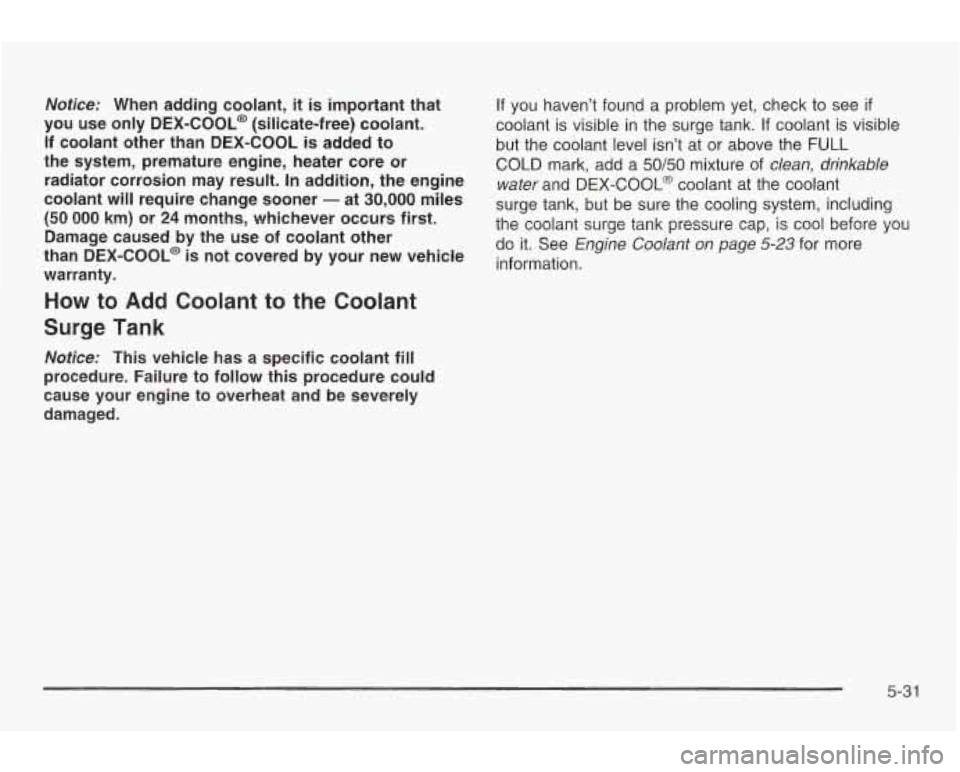
Notice: When adding coolant, it is important that
you use only
DEX-COOL@ (silicate-free) coolant.
If coolant other than DEX-COOL
is added to
the system, premature engine, heater core or
radiator corrosion may result.
In addition, the engine
coolant will require change sooner
- at 30,000 miles
(50 888 km) or 24 months, whichever occurs first.
Damage caused by the use of coolant other
than DEX-COOL@ is not covered by your new vehicle
warranty.
How to Add Coolant to the Coolant
Surge Tank
Nofice: This vehicle has a specific coolant fill
procedure. Failure to follow this procedure could
cause your engine to overheat and be severely
damaged.
If you haven’t found a problem yet, check to see if
coolant is visible in the surge tank. If coolant is visible
but the coolant level isn’t at or above the
FULL
COLD mark, add a 50/50 mixture of clean, drinkable
water
and DEX-COOL@ coolant at the coolant
surge tank, but be sure the cooling system, including
the coolant surge tank pressure cap, is cool before
you
do it. See Engine Coolant on page 5-23 for more
information.
5-31
Page 258 of 354
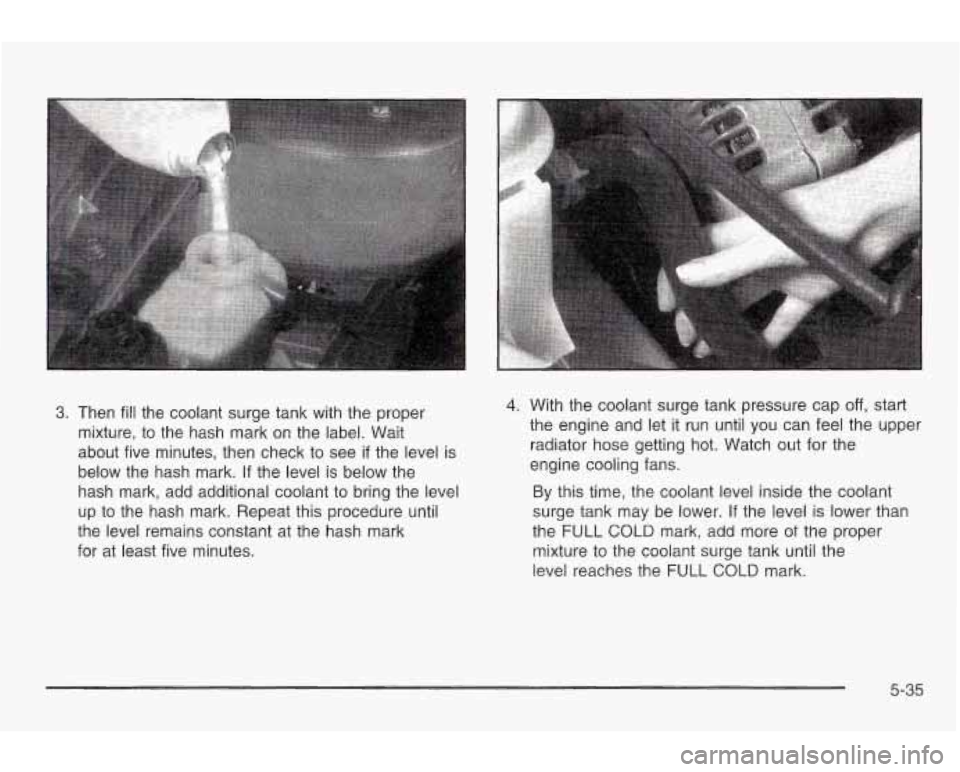
3. Then fill the coolant surge tank with the proper
mixture, to the hash mark on the label. Wait
about five minutes, then check to see
if the level is
below the hash mark. If the level is below the
hash mark, add additional coolant to bring the level
up to the hash mark. Repeat this procedure until
the level remains constant at the hash mark
for at least five minutes.
4. With the coolant surge tank pressure cap off, start
the engine and let it run until you can feel the upper
radiator hose getting hot. Watch out for the
engine cooling fans.
By this time, the coolant level inside the coolant
surge tank may be lower. If the level
is lower than
the FULL
COLD mark, add more of the proper
mixture to the coolant surge tank until the
level reaches the FULL COLD mark.
5-35
Page 259 of 354

5. Then replace the pressure cap. Be sure the
pressure cap is hand-tight and fully seated.
See your dealer,
if necessary.
Power Steering Fluid
A
L- A
When to Check Power Steering Fluid
See Engine Compartment Overview on page 5-12
for reservoir location.
It is not necessary to regularly check power steering
fluid unless you suspect there is a leak in the system or
you hear an unusual noise.
A fluid loss in this system
could indicate a problem. Have the system inspected
and repaired.
5-36
Page 260 of 354
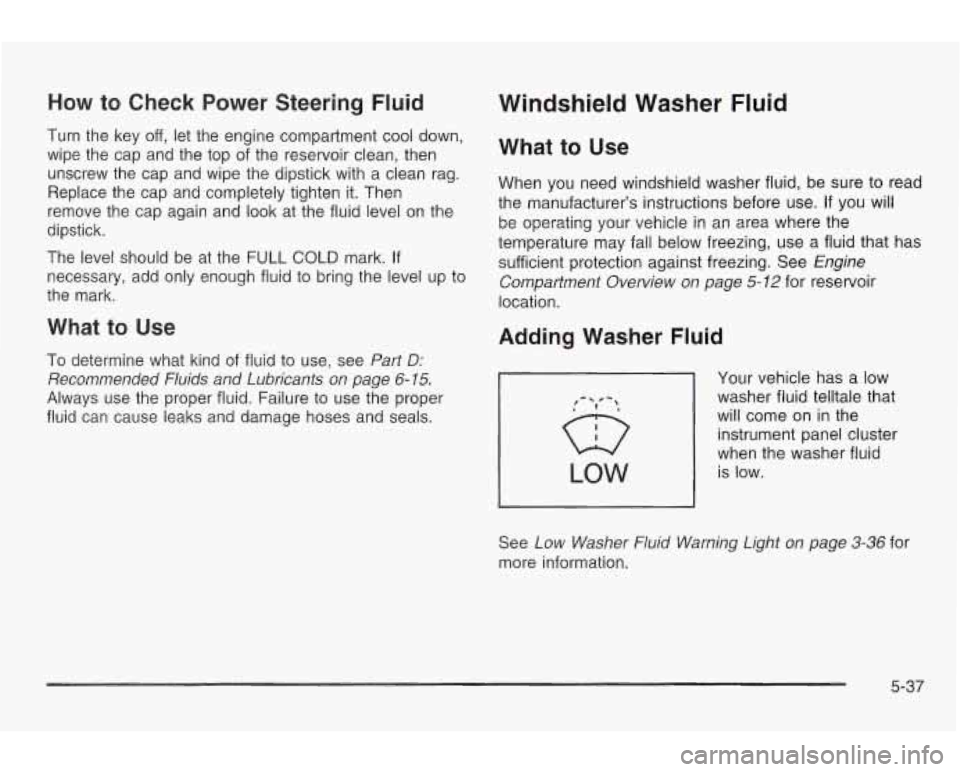
How to Check Power Steering Fluid
Turn the key off, let the engine compartment cool down,
wipe the cap and the top of the reservoir clean, then
unscrew the cap and wipe the dipstick with a clean rag.
Replace the cap and completely tighten it. Then
remove the cap again and look at the fluid level on the
dipstick.
The level should be at the
FULL COLD mark. If
necessary, add only enough fluid to bring the level up to
the mark.
What to Use
To determine what kind of fluid to use, see Part D:
Recommended Fluids and lubricants on page 6- 15.
Always use the proper fluid. Failure to use the proper
fluid can cause leaks and damage hoses and seals.
Windshield Washer Fluid
What to Use
When you need windshield washer fluid, be sure to read
the manufacturer's instructions before use. If you
will
be operating your vehicle in an area where the
temperature may fall below freezing, use a fluid that has
sufficient protection against freezing. See
Engine
Compartment Overview on page
5-12 for reservoir
location.
Adding Washer Fluid
.1. ,- 5 * -,
LOW
Your vehicle has a low
washer fluid telltale that
will come on in the
instrument panel cluster
when the washer fluid
is low.
See
low Washer Fluid Warning light on page 3-36 for
more information.
5-37
Page 267 of 354
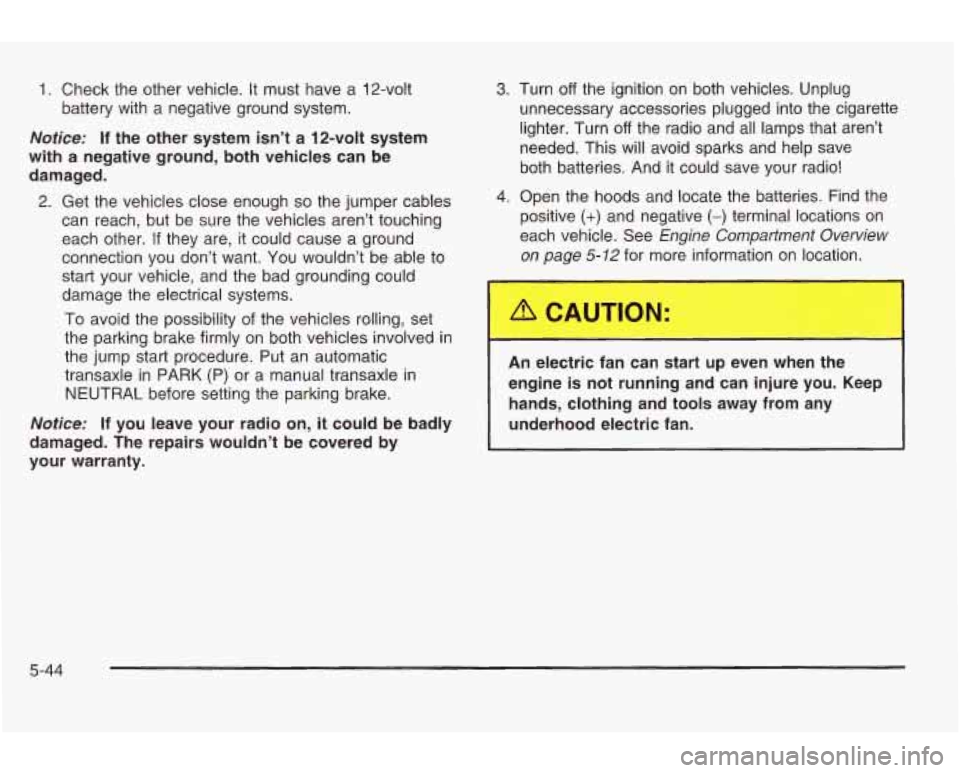
1. Check the other vehicle. It must have a 12-volt
battery with a negative ground system.
Notice: If the other system isn’t a 12-volt system
with a negative ground, both vehicles can be
damaged.
2. Get the vehicles close enough so the jumper cables
can reach, but be sure the vehicles aren’t touching
each other. If they are, it could cause a ground
connection you don’t want. You wouldn’t be able
to
start your vehicle, and the bad grounding could
damage the electrical systems.
To avoid the possibility of the vehicles rolling, set
the parking brake firmly on both vehicles involved in
the jump start procedure. Put an automatic
transaxle in PARK (P) or a manual transaxle in
NEUTRAL before setting the parking brake.
Notice: If you leave your radio on, it could be badly
damaged. The repairs wouldn’t be covered by
your warranty.
3. Turn off the ignition on both vehicles. Unplug
unnecessary accessories plugged into the cigarette
lighter. Turn
off the radio and all lamps that aren’t
needed. This will avoid sparks and help save
both batteries. And it could save your radio!
4. Open the hoods and locate the batteries. Find the
positive (+) and negative
(-) terminal locations on
each vehicle. See
Engine Compartment Overview
on page
5-12 for more information on location.
c
An electric fan can start up even when the
engine
is not running and can injure you. Keep
hands, clothing and tools away from any
underhood electric fan.
5-44
Page 268 of 354
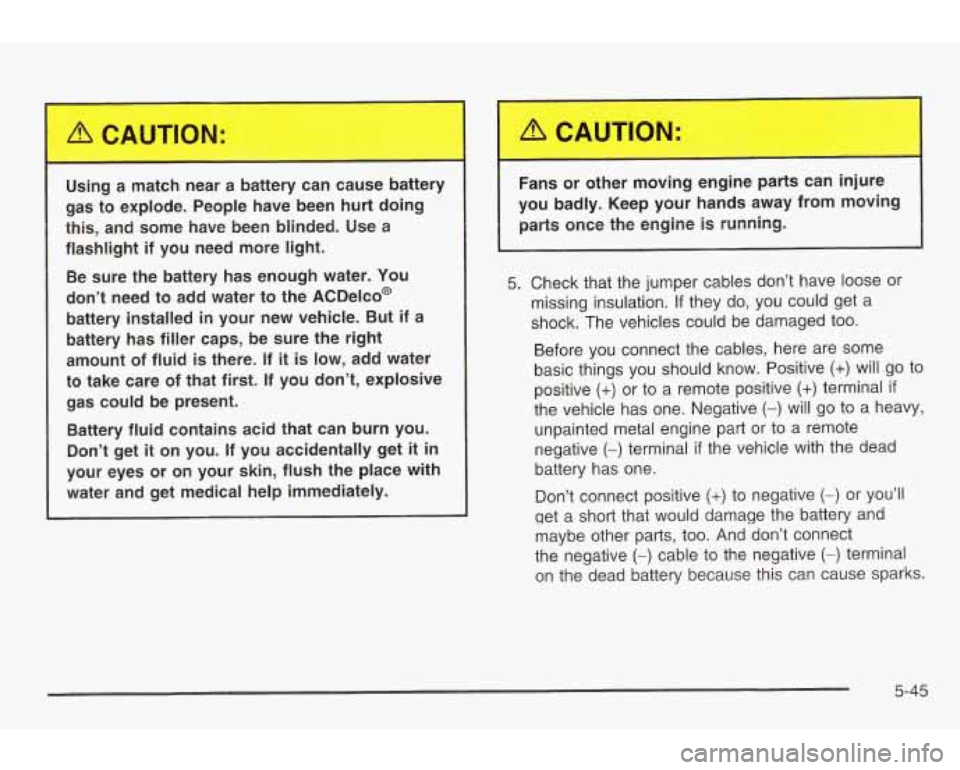
Using a match near a battery can cause battery
gas to explode. People have been hurt doing
this, and some have been blinded. Use a
flashlight if you need more light.
Be sure the battery has enough water. You
don’t need to add water to the ACDelco@
battery installed in your new vehicle. But if a
battery has filler caps, be sure
the right
amount of fluid is there. If
it is low, add water
to take care of that first. If you don’t, explosive
gas could be present.
Battery fluid contains acid that can burn you.
Don’t get it on you. If you accidentally get
it in
your eyes or on your skin, flush the place with
water and get medical help immediately. Fans or other moving engine parts can injure
you badly. Keep your hands away from moving
parts
once the engine is running.
5. Check that the jumper cables don’t have loose or
missing insulation. If they do, you could get a
shock. The vehicles could be damaged too.
Before you connect the cables, here are some
basic things you should know. Positive
(+) will go to
positive
(+) or to a remote positive (+) terminal if
the vehicle has one. Negative (-) will go to a heavy,
unpainted metal engine part or to a remote
negative
(-) terminal if the vehicle with the dead
battery has one.
Don’t connect positive
(+) to negative (-) or you’ll
qet a short that would damage the battery and
maybe other parts, too. And don’t connect
the negative
(-) cable to the negative (-) terminal
on the dead battery because this can cause sparks.
5-45